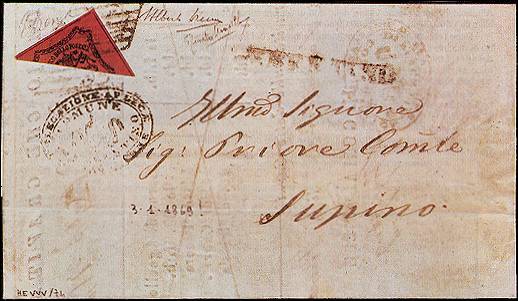
Fig. 1: the only known splitting of the 2nd issue
(from "Catalogo Sassone Specializzato" ed. 2002)
The
bisect
I have already mentioned in the introduction to the Roman States issues (especially to the first one) and of the Romagne how, out of the more characteristic use of these stamps there is the one under the form of "split ones".
I open therefore a short parenthesis not closely related to the stamps themselves but to a specific use of them: for the importance of the subject I thought as necessary at least a short mention.
The use more or less authorized and tolerated of dividing in two or more parts a stamp is not peculiar of the Roman States only: in old philately several examples of this use are known from several States and several periods.
The main reason of the splitting is to obtain a value at the moment not available for shortage of specific stamps.
Just to make an example: if the stock of the 1 Baj was down, to satisfy the demand, the 2 Baj was cut obtaining... two stamps of 1 Baj.
A system a bit particular but, by sure, efficient!
This procedure was applied with relative frequency in the Roman States Postal Offices (especially in some values), also because even if not approved by the Postal Administration it was by sure tolerated specially at the beginning. Only later on, due to the possibility of cheating, specific rules were issued to veto this type of usage; for that reason we cannot exclude that this system had been used to "cover" some postal employee without so many scruples in the reuse of some stamp just partially cancelled. In fact some people believes that most of the "split ones" do have this origin!
have already said that once the Romagne territory became separated and independent the first stamps to be used have still been the ones from Roman States issues that went quickly to exhaustion also because the Postal Administration distribution was done in small quantities (see Romagne introduction). For this reason the use of the split ones was present here too.
It's almost not necessary to recall that the stamps, or what is left (!), must be preserved, as much is possible, on fragment and with complete cancellation: much better (and even more rare) if they are still preserved on the envelope itself.
The most frequent cancellation found is the grid. The first known date of a split one of the first issue is January 10th 1852 (2 Baj split in two halves) and the last one is August 6th 1867 (4 Baj split in two halves).
Differently from what happens in the first issue, where to find split ones is not common but not rare too, the use of this method in the following issues in centesimi is an exceptional event: only one letter is known with a split one of the second issue (10 centesimi split diagonally in two on a letter from Ferentino to Supino of Junuary 3rd 1869 - Fig. 1). For what is related to the third issue, some fragment is known as well as only one letter with a 5 centesimi diagonally cut in two halves (from Roma to Montefiorino of March 12th 1870 - Fig. 2). Some fragment and very few letters with the 10 centesimi diagonally split (Fig. 3) are also known.

Fig. 1:
the only known splitting of the 2nd issue
(from "Catalogo Sassone Specializzato" ed. 2002)
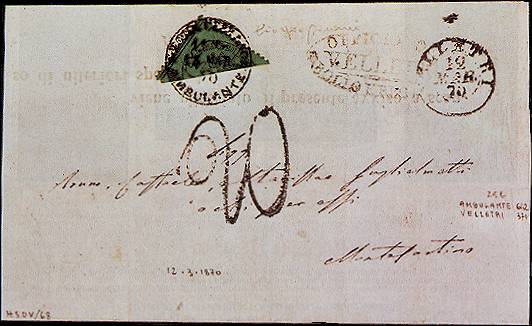
Fig. 2:
the only known splitting of the 5 centesimi of the 3rd issue
(from "Catalogo Sassone Specializzato" ed. 2002)
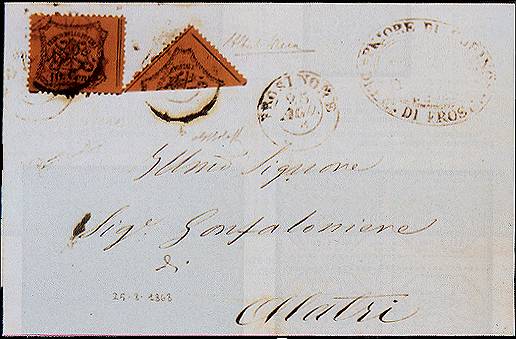
Fig. 3:
one of the very few known fragments of the 3rd issue
(from "Catalogo Sassone Specializzato" ed. 2002)
- - - - - - - - -
I'm giving here a sketched summary of the various known splitting types of the 1st issue, by leaving away the list of the different cancellations with these stamps as well as of the specific color shades of the split one, to avoid to create a list too specialist and complex.
Some split stamps, if not unique are exceptionally rare. I suggest strongly to the collectors the highest attention in the purchase of these stamps, due to huge and dangerous forgeries present on the market.
| Table key |
Value
|
A
|
B
|
C
|
D
|
E
|
F
|
G
|
H
|
L
|
| A: Diagonal half |
1/2
Baj
|
X
|
X
|
X
|
||||||
| B: Vertical half |
1
Baj
|
X
|
X
|
X
|
X
|
|||||
| C: Horizontal half |
2
Baj
|
X
|
X
|
X
|
X
|
|||||
| D: Left 1/3 |
3
Baj
|
X
|
X
|
X
|
X
|
X
|
X
|
X
|
||
| E: Middle 1/3 |
4
Baj
|
X
|
X
|
X
|
X
|
|||||
| F: Right 1/3 |
5
Baj
|
X
|
X
|
X
|
||||||
| G: 2/3 |
6
Baj
|
X
|
X
|
X
|
X
|
X
|
X
|
X
|
||
| H: 1/4 |
7
Baj
|
X
|
X
|
|||||||
| L: 1/6 |
8
Baj
|
X
|
X
|
X
|
X
|
I show now some beautiful split ones: these particular frankings always offer great charm and interest.
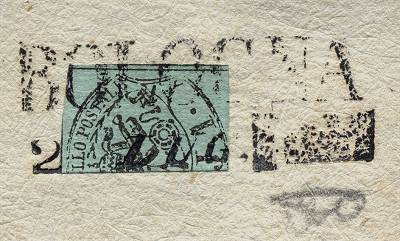
Fig. 4:
1 Baj cut vertically in half
Linear Bologna cancellation with mute year
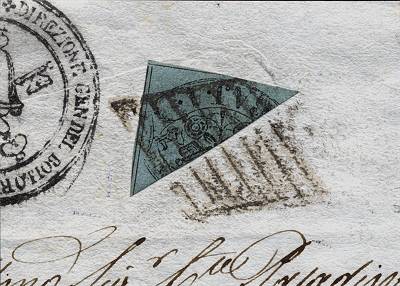
Fig. 5:
1 Baj diagonally split in two
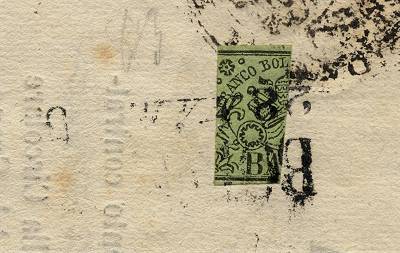
Fig. 6:
2 Baj vertically split in two
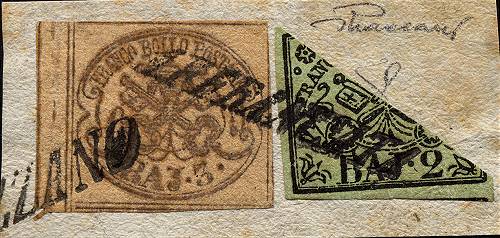
Fig. 7: 2 Baj diagonally split
in two with mixed franking with a 3 Baj
with oily printing and with group inter-space on the left
Linear cancellations "Bazzano" and "Affrancata". Unique
combination.